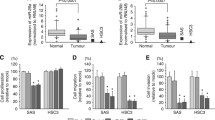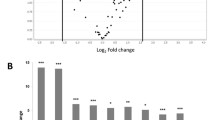Abstract
Background
Tongue squamous cell carcinoma (TSCC) is a major subtype of head and neck squamous cell carcinoma (HNSCC), which is an intractable cancer with a poor prognosis. Studies have shown that microRNAs (miRNAs) play an important role in TSCC biology. However, the expression and functions of miRNAs in TSCC remain unclear.
Methods
The non-coding RNA profiles of TSCC were downloaded from the GEO database. WGCNA (Weighted gene co-expression network analysis) and differential expression miRNA (DE-miRNA) analyses were employed to identify key candidate miRNAs. miRNA expression was detected using RT-qPCR analysis. The target genes of key miRNAs were predicted. Gene ontology and Kyoto Encyclopedia of Genes and Genomes pathway enrichment analyses were performed to explore the potential functions and pathways of key miRNA. miRNA inhibitor was transfected to detect the function of miRNA. The effect of miRNA deregulation on TSCC cell proliferation and apoptosis was investigated using MTS, Annexin V-FITC/PI double staining, and flow cytometry assays.
Results
miR-27a was a key miRNA in TSCC, which was significantly up-regulated in both Cal-27 cells and malignant tissues from the TSCC patients. In addition, functional analysis showed that miR-27a was involved in the regulation of the MAPK, ERBB, and Jak-STAT signaling pathways. Moreover, RHOA and PRKACA were potential target genes of miR-27a, suggesting them as possible mediators of the tumor-promoting effect of miR-27a. Moreover, downregulation of miR-27a inhibited cell proliferation and facilitated cell apoptosis in Cal-27 cells.
Conclusion
Our findings strongly suggest that miR-27a could promote the tumorigenesis and development of TSCC, which makes it a potential new diagnostic marker and therapeutic target for TSCC.







Similar content being viewed by others
Availability of data and materials
The non-coding RNA profiles of TSCC GSE28100 were downloaded from the GEO database (http://www.ncbi.nlm.nih.gov/geo/).
References
Scheff NN, Ye Y, Bhattacharya A et al (2017) Tumor necrosis factor alpha secreted from oral squamous cell carcinoma contributes to cancer pain and associated inflammation. Pain 158(12):2396–2409
Fatehi KS, Thiagarajan S, Dhar H, Chaukar D, DCruz AK (2019) Squamous cell carcinoma of the tongue in a patient with dyskeratosis congenita: a rare entity. Br J Oral Maxillofac Surg 57(1):79–81
Klingelhöffer C, Gründlinger A, Spanier G et al (2018) Patients with unilateral squamous cell carcinoma of the tongue and ipsilateral lymph node metastasis do not profit from bilateral neck dissection. Oral Maxillofac Surg 22(2):185–192
Sinha N, Rigby MH, McNeil ML et al (2018) The histologic risk model is a useful and inexpensive tool to assess risk of recurrence and death in stage I or II squamous cell carcinoma of tongue and floor of mouth. Mod Pathol 31(5):772–779
Rani P, Gupta AJ, Mehrol C, Singh M, Khurana N, Passey JC (2020) Clinicopathological correlation of tumor-stroma ratio and inflammatory cell infiltrate with tumor grade and lymph node metastasis in squamous cell carcinoma of buccal mucosa and tongue in 41 cases with review of literature. J Cancer Res Ther 16(3):445–451
Banikazemi Z, Haji HA, Mohammadi M et al (2018) Diet and cancer prevention: dietary compounds, dietary MicroRNAs, and dietary exosomes. J Cell Biochem 119(1):185–196
Keshavarzi M, Sorayayi S, Jafar Rezaei M et al (2017) MicroRNAs-based imaging techniques in cancer diagnosis and therapy. J Cell Biochem 118(12):4121–4128
Zhang WC (2019) microRNAs tune oxidative stress in cancer therapeutic tolerance and resistance. Int J Mol Sci. https://doi.org/10.3390/ijms20236094
Moles R (2017) MicroRNAs-based therapy: a novel and promising strategy for cancer treatment. Microrna 6(2):102–109
Babaei K, Shams S, Keymoradzadeh A et al (2020) An insight of microRNAs performance in carcinogenesis and tumorigenesis; an overview of cancer therapy. Life Sci 240:117077
Ohta K, Yoshimura H (2019) Squamous cell carcinoma of the dorsal tongue. CMAJ 191(47):E1310
Zhang H, Liu J, Fu X, Yang A (2017) Identification of key genes and pathways in tongue squamous cell carcinoma using bioinformatics analysis. Med Sci Monit 23:5924–5932
Steens S, Bekers EM, Weijs W et al (2017) Evaluation of tongue squamous cell carcinoma resection margins using ex-vivo MR. Int J Comput Assist Radiol Surg 12(5):821–828
Yao Y, Lin W, Zhang Y (2018) Fabrication of tongue extracellular matrix and reconstitution of tongue squamous cell carcinoma in vitro. J Vis Exp. https://doi.org/10.3791/57235
Mishra S, Yadav T, Rani V (2016) Exploring miRNA based approaches in cancer diagnostics and therapeutics. Crit Rev Oncol Hematol 98:12–23
Qadir MI, Faheem A (2017) miRNA: a diagnostic and therapeutic tool for pancreatic cancer. Crit Rev Eukaryot Gene Expr 27(3):197–204
Lee YS, Dutta A (2009) MicroRNAs in cancer. Annu Rev Pathol 4:199–227
Rupaimoole R, Slack FJ (2017) MicroRNA therapeutics: towards a new era for the management of cancer and other diseases. Nat Rev Drug Discov 16(3):203–222
Javanmardi S, Aghamaali MR, Abolmaali SS, Mohammadi S, Tamaddon AM (2017) miR-21, an oncogenic target mirna for cancer therapy: molecular mechanisms and recent advancements in chemo and radio-resistance. Curr Gene Ther 16(6):375–389
Manfredi M, Brandi J, Di Carlo C et al (2019) Mining cancer biology through bioinformatic analysis of proteomic data. Expert Rev Proteomics 16(9):733–747
Huang X, Liu S, Wu L, Jiang M, Hou Y (2018) High throughput single cell rna sequencing, bioinformatics analysis and applications. Adv Exp Med Biol 1068:33–43
Esquela-Kerscher A, Slack FJ (2006) Oncomirs-microRNAs with a role in cancer. Nat Rev Cancer 6(4):259–269
Yan H, Siu HC, Law S et al (2018) A comprehensive human gastric cancer organoid biobank captures tumor subtype heterogeneity and enables therapeutic screening. Cell Stem Cell 23(6):882-897.e11
Liu D, Mei X, Wang L, Yang X (2017) RhoA inhibits apoptosis and increases proliferation of cultured SPCA1 lung cancer cells. Mol Med Rep 15(6):3963–3968
Kalpana G, Figy C, Yeung M, Yeung KC (2019) Reduced RhoA expression enhances breast cancer metastasis with a concomitant increase in CCR5 and CXCR4 chemokines signaling. Sci Rep 9(1):16351
Dopeso H, Rodrigues P, Bilic J et al (2018) Mechanisms of inactivation of the tumour suppressor gene RHOA in colorectal cancer. Br J Cancer 118(1):106–116
Zhang GY, Yang WH, Chen Z (2016) Upregulated STAT3 and RhoA signaling in colorectal cancer (CRC) regulate the invasion and migration of CRC cells. Eur Rev Med Pharmacol Sci 20(10):2028–2037
Song L, Guo Y, Xu B (2017) Expressions of Ras Homolog Gene Family, Member A (RhoA) and Cyclooxygenase-2 (COX-2) proteins in early gastric cancer and their role in the development of gastric cancer. Med Sci Monit 23:2979–2984
Singhi AD, Wood LD, Parks E et al (2020) Recurrent rearrangements in PRKACA and PRKACB in intraductal oncocytic papillary neoplasms of the pancreas and bile duct. Gastroenterology 158(3):573–582
Vyas M, Hechtman JF, Zhang Y et al (2020) DNAJB1-PRKACA fusions occur in oncocytic pancreatic and biliary neoplasms and are not specific for fibrolamellar hepatocellular carcinoma. Mod Pathol 33(4):648–656
Kastenhuber ER, Lalazar G, Houlihan SL et al (2017) DNAJB1-PRKACA fusion kinase interacts with β-catenin and the liver regenerative response to drive fibrolamellar hepatocellular carcinoma. Proc Natl Acad Sci U S A 114(50):13076–13084
Yang F, Xie HY, Yang LF et al (2020) Stabilization of MORC2 by estrogen and antiestrogens through GPER1- PRKACA-CMA pathway contributes to estrogen-induced proliferation and endocrine resistance of breast cancer cells. Autophagy 16(6):1061–1076
Wang B, Zhao CH, Sun G et al (2019) IL-17 induces the proliferation and migration of glioma cells through the activation of PI3K/Akt1/NF-κB-p65. Cancer Lett 447:93–104
Hu Z, Luo D, Wang D, Ma L, Zhao Y, Li L (2017) IL-17 Activates the IL-6/STAT3 signal pathway in the proliferation of hepatitis B virus-related hepatocellular carcinoma. Cell Physiol Biochem 43(6):2379–2390
Pistritto G, Trisciuoglio D, Ceci C, Garufi A, D’Orazi G (2016) Apoptosis as anticancer mechanism: function and dysfunction of its modulators and targeted therapeutic strategies. Aging (Albany NY) 8(4):603–619
Kaczanowski S (2016) Apoptosis: its origin, history, maintenance and the medical implications for cancer and aging. Phys Biol 13(3):031001
Wang BQ, Yang B, Yang HC et al (2018) MicroRNA-499a decelerates glioma cell proliferation while accelerating apoptosis through the suppression of Notch1 and the MAPK signaling pathway. Brain Res Bull 142:96–106
Author information
Authors and Affiliations
Contributions
Conception and design: HC, KY, ZD. Administrative support: YC, YC. Collection and assembly of data: KY. Data analysis and interpretation: KY, PS. Manuscript writing: KY. Final approval of manuscript: All authors.
Corresponding author
Ethics declarations
Ethics approval
The research protocol for this study was approved by the Ethics Committee of the Fourth Hospital of Hebei Medical University. Consent from all patients was obtained at the time of sample collection.
Consent for publication
The authors have no ethical, legal and financial conflicts related to the article. All authors read and approved the manuscript to publish.
Additional information
Publisher's Note
Springer Nature remains neutral with regard to jurisdictional claims in published maps and institutional affiliations.
Rights and permissions
About this article
Cite this article
Chen, H., Dong, Z., Chen, Y. et al. MicroRNA-27a promotes tumorigenesis in tongue squamous cell carcinoma by enhancing proliferation, migration and suppressing apoptosis. Eur Arch Otorhinolaryngol 278, 4557–4567 (2021). https://doi.org/10.1007/s00405-021-06837-y
Received:
Accepted:
Published:
Issue Date:
DOI: https://doi.org/10.1007/s00405-021-06837-y




